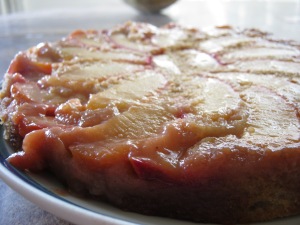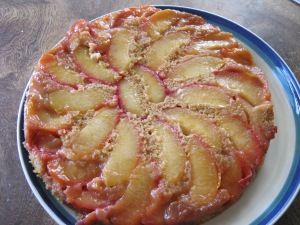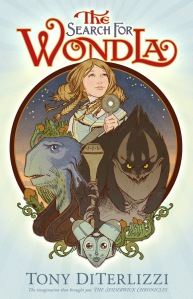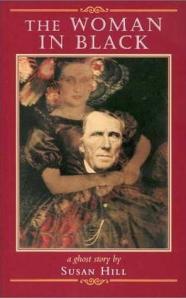It’s midsummer and plums are cheap right now, so I decided to do a baking experiment.


This is plum upside-down cake, which is pretty much pineapple upside-down cake but with plums. The principle seemed like it would be the same: lay some fruit in the bottom of the pan, pour cake batter on top, cook then flip, so I decided to take James Beard’s general recipe for upside-down cake and play around with it. Oh, yes, the experiment was a success. This cake didn’t last very long in my apartment.
.
Plum Upside-Down Cake (Adapted from James Beard)
Fruit part:
- Four medium-sized plums
- 2 tablespoons butter
- 1/8 cup brown sugar
Cake batter:
- 1/4 cup butter
- 1/2 cup brown sugar
- 1 egg
- 1 cup flour (JB calls for cake flour, but mine turned out fine with all purpose)
- 1 teaspoon baking powder
- 1/4 teaspoon salt
- 1/4 teaspoon allspice and 1/4 teaspoon ground cloves (or use cinnamon or ginger or whatever spices you like)
- 1/2 teaspoon vanilla
- just over 1/3 cup of milk
Preheat the oven to 350º. Wash the plums and slice into wedges. Remove pits. Put the 2 tablespoons of butter in the bottom of a 9-inch round baking pan, then put the pan in the oven just long enough for the butter to melt. Take the pan back out, then sprinkle the brown sugar over the bottom. Lay the plum wedges in the bottom of the pan (you can do it decoratively if you want).
Cream together butter and sugar until fluffy, then beat in the egg, then mix in vanilla. In another bowl, mix flour, baking powder, salt, spices. Add part of the flour mixture to the butter-sugar mixture and mix, then the milk, then the rest of the flour mixture. Mix only just enough so that everything is combined.
Pour the cake batter into the pan, over the plum wedges. Gently press the batter into the edges of the pan so it’s well-distributed. Bake for 30 minutes or when cake in the center of the pan is springy and not wet. Take the cake out of the over and let it cool before you try to flip it out of the pan!
Once the cake is quite cool, put a dinner plate on top of the pan and hold the edges of pan and plate together firmly. Flip. Once it’s upside-down, if the cake’s not coming out of the pan, you can whack it against a countertop. If all goes well, you will have a cake with lovely wedges of plum laid into the top. Enjoy!









